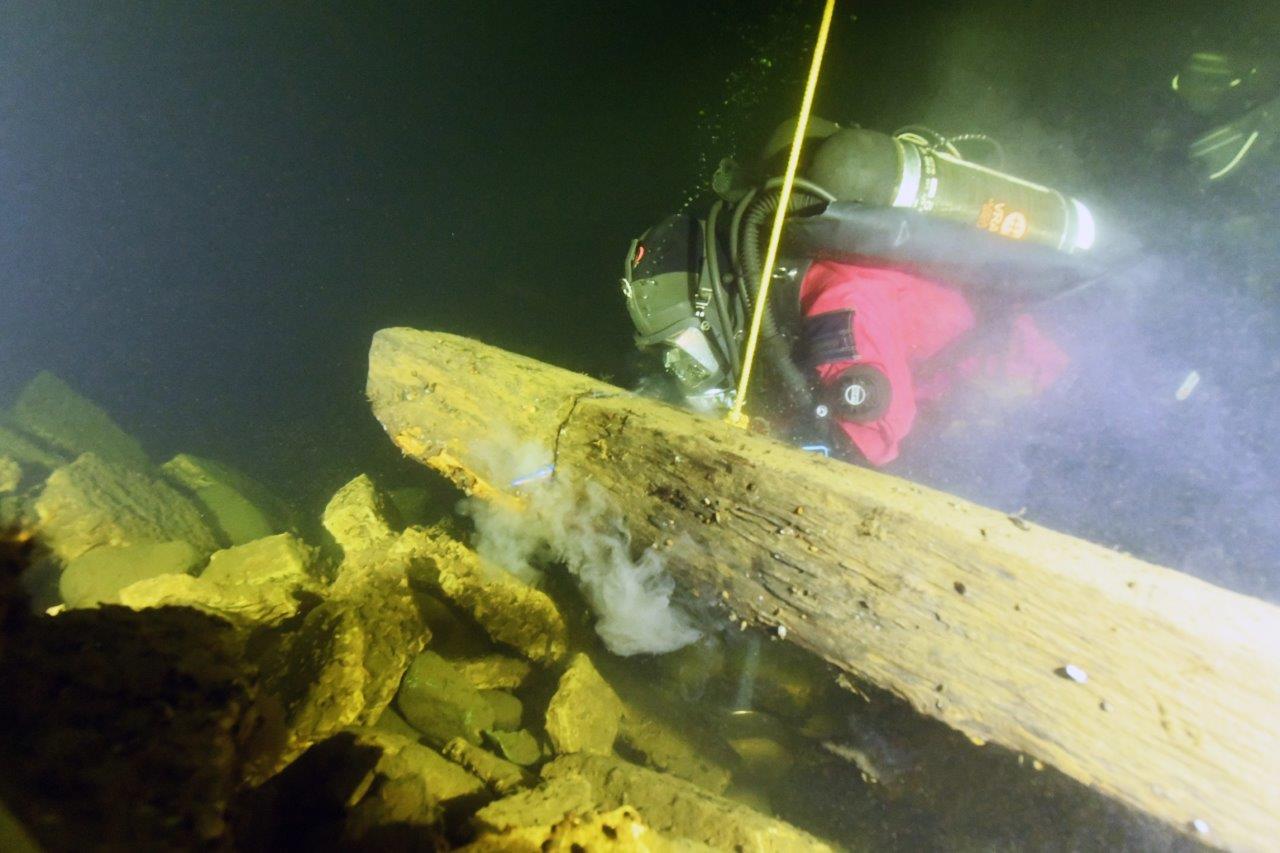
The wreck in question is located in the middle of the Nämdöfjärden, at the Franska Stenarna shoal, and may be a ship belonging to King Gustav Vasa that sank in 1525. A contemporary source describes it as “His Majesty’s best Kravel”. It was said to have been loaded with a large number of guns and was travelling from Kalmar to Stockholm.
The wreck holds significant cultural and historical value, and the wreck site itself is complex in several ways. For example, the remains are spread across three distinct areas. Some of the remains are found in a slightly shallower part while others lie somewhat deeper.
Maritime archaeologists have examined Kraveln before, including taking dendrological samples. New samples are now being taken from the remains in both the deep and the shallow parts of the wreck site. This is being done both to establish whether the remains belong together, and to be able to pinpoint the dates.
Marco Ali, maritime archaeologist and project manager for the work on Kraveln, says:
“Now we want to find out if a hull side that lies east of the shoal belongs to the rest of the wreck, which is located north of the shoal and much deeper. We noticed that both the wreck and the detached hull side are mostly built in oak with pine details, which makes it even more urgent to ensure that they belong to the same ship.”
Last spring, dendrochronological samples were taken from the hull side and, after analysis, they showed a dating around the year 1440.
“We were also able to discover that the trees for the ship’s timber had grown in present-day Lithuania,” says Jim Hansson, one of the museum’s maritime archaeologists.
Shipwreck dating is a puzzle for maritime archaeologists. A sample taken in 1994 from the wreckage north of the shoal (in the deep part) was dated first to 1507 and later to 1512. One question is whether these could be two different wrecks, since the results reveal that there is a difference of more than 70 years between the different parts.
“When we discussed this with the people who analysed our new samples, they explained that the 1994 sample should now be considered undated. A reliable dating is simply not possible,” Hansson says.
There are plenty of questions that need to be cleared up. One key question is, of course, whether the wreck is Kraveln at all. Does the shallow hull side belong to the other remains? And finally, when could the ship have been built?
“So, we have a definite date for the hull side in the shallow part, which indicates the 15th century, but no date for the deeper wreck. We’ve found artefacts that can be dated to the 15th to 16th centuries at both sites, but we need more precise dating to be able to date the ship with certainty and to determine whether the hull side relates to other parts of the wreck,” Ali says.
The wreck is interesting because it can offer greater insight into the evolution of shipbuilding technology during the Middle Ages. Based on the technology that can be discerned on the wreck remains, and with the help of the artefacts found, the wreck can be dated to the early 16th century. There are some similarities between Kraveln and another known 16th century ship, the Osmund wreck, which was built in the early 16th century and wrecked in the 1560s. Maritime archaeologists are now waiting for the results of new dendroanalyses to confirm the date.
“The new samples will give us clarity on the history of the wreck, and hopefully confirm our theory that the shallow and deep parts are connected,” Ali says.
The period spanning the mid-15th century and the following 100 years was a turning point in the development of ship technology. During this time, there was a transition from clinker construction to shell construction and carvel planking.
“We don’t know exactly when the transition took place, but we hope that this survey will provide more information and clarity around that, too,” Hansson says.
Fruitful co-operation among the authorities
Knowing that the wreck is possibly one of Gustav Vasa’s vessels makes it appealing to many divers. In fact, several recreational divers have known about it ever since the 1960s. But it wasn’t until 1991 that the wreck was officially “discovered”, and maritime archaeologists got the chance to examine it. Since then, there has been a ban on anchoring and diving at the site to protect the wreck from looting.
Unfortunately, bans don’t always help. Over the years, archaeologists have observed evidence of unauthorised diving and looting. These activities can be carried out undisturbed because the site is located in the center of the bay, far from any settlements. This is where co-operation with the coast guard comes into play.
Since 2018, maritime archaeologists at the Museum of Wrecks have enjoyed a fruitful collaboration with the coast guard, maritime police and navy. We are all part of a long-term project aimed at preserving cultural heritage below the surface and protecting wrecks and other remains on the seabed from looting and destruction. The archaeologists are experts on how to detect shipwrecks, examine the wreckage and other remains, and how to take samples and photos. The coast guard, together with the maritime police, will monitor and prosecute cultural heritage offences below the surface.
This week’s collaborative surveys are part of ongoing efforts to preserve and safeguard our maritime heritage.
“In co-operation with the coast guard, we practice together on different wrecks,” Hansson says. “For example, we teach them how to uncover an object under water. And they have helped us by providing boats, equipment and divers.”
He continues, “We learn more about how we should photograph wrecks and remains that have been subject to crime, so that the pictures will stand up in court. We, in turn, teach our partners how to dig to minimise damage. We simply help each other with the resources each of us has.”